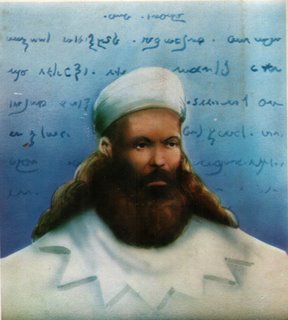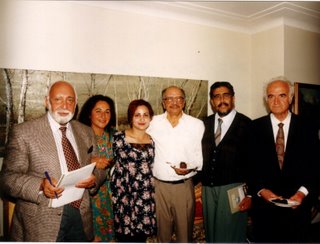Sunday, April 02, 2006
297. شعر: نگاهبان ِ فرهنگ ِ هندو - ايراني
 زرتشت كهن ترين شاعر و فيلسوف جهان
زرتشت كهن ترين شاعر و فيلسوف جهانيادداشت ويراستار
درباره ي خاستگاه ها و بُنيادهاي هنر شعر در زبانها و فرهنگهاي گوناگون انساني، تاكنون جُستارهاي بسيار به كار رفته و گفتارها و كتابهاي فراوان نوشته شده است. فرهنگ قوم هاي هندو - ايراني -- كه فرهنگ كهن ِ ما شاخه اي از آن است -- گنجينه اي از اين يادمان هاي ديرينه را در خود داشته است كه هم در ادب ِ ودايي ي هندوان و هم در گاهان جاودانه ي زرتشت -- كهن ترين شاعر و فيلسوف جهان -- برجامانده است.
شاعر بزرگ و بنيادگذار و نوآور ِ روزگار ما نيما يوشيج در روشنگري ي چگونگي ي ساختارمند شدن ِ دستاوردهاي شعري اش، نوشته است:
"از گاتها (گاهان) آغاز مي كنم كه فرمان ِ نخستين است."
*
در اين راستا، گاهان پژوه ِ دانشمند و دوست ِ پژوهنده ي نامدارم، دكتر علي اكبر جعفري، گفتار ارزشمند و رهنموني نوشته و متن آن را با مهر ِ هميشگي شان به اين كوشنده، بدين دفتر فرستاده اند كه من آن را با رواديد ِ ويژه ي ايشان، براي آگاهي و برخورداري ي خوانندگان ِ جويا و پوياي اين تارنما، در پي مي آورم. (برگردان ِ فارسي ي ِ گُفتاوَرد از گاهان را من از روي كتاب ايشان، افزوده ام.)
آفرين و درود بر استاد جعفري!
جليل دوستخواه
چهاردهم فروردين ماه 1385
 از راست به چپ: دكتر حسين وحيدي، جليل دوستخواه، دكتر علي اكبر جعفري،
از راست به چپ: دكتر حسين وحيدي، جليل دوستخواه، دكتر علي اكبر جعفري،آرتميس كيواني، مهرآور مرزباني و ابوالقاسم پرتو اعظم
در شب ِ آيين ِ پاياني ي ِ گردهمايي و جشنواره ي ده روزه ي ايران شناختي
سيدني - استراليا- مهرگان 1373
POETRY PRESERVING INDO-IRANIAN CULTURE
ýathrâ vê afshmânî sêñghânî
nôit anafshmãm dêjâmâspâ hvôgvâ
hadâ vêstâ vahmêñg seraoshâ râdanghô
ýê vîcinaot dâthemcâ adâthemcâ
dañgrâ mañtû ashâ mazdâ ahurâ.
Here, Sage Jamaspa Hvogva, I teach you my message
in a poetic and not in an un-poetic language,
so that it shall always stay with you
as prayers of glorification with the divine inspiration.
Whoever distinguishes between the just and the unjust,
Wise Lord, is, through righteousness, a wonderful counselor.
(Gathas: 11.17)
"اي جاماسپ ِ دانا! اينك پيام ِ خود را برايت به شعر مي سرايم، نه به نثر تا آن با دانش ِ دروني به پيكر ِ نيايش، براي جويندگان ِ راستي بماند. اي خداي ِ دانا! هركس كه داد را از بيداد بازبشناسد، به راستي رايزن ِ شگفت انگيز است."
(گزارش و برگردان ِ سْتَوتْ يَسْن، داراي ِ گاتها، سرودهاي ِ پاك ِ زرتشت ِ اسپَنتْمان و هفت هات و ديگرْ گفته هاي ياران، به پارسي ِ روان از علي اكبر جعفري، چاپ ِ اوشتا، كاليفرنيا - 1993 ميلادي، ص 105)
Poetry is as old as the dawning age when humans listened to musical animal sounds, particularly the birds. Singing it was definitely accompanied by body movements. It was the beginning of dance that had both—song and music. It is very much alive allover the world, from the still primitive people to the pop-music populace. Time gave it the credal colors and ballad blends.
But it was the Indo-Iranians who turned it into the fine art of recording their culture. They realized that a poetry piece can accurately be repeated, preserved in memory and passed on to new generations. Compared to prose, which changed even if repeated by the same person a little later, poetry remained unadulterated even by those who recited it generations after. They developed it high and sublime to safeguard their creed.
We see the Indians have preserved their Hymns in praise of their gods and goddesses in 1017 songs. The collection is called Rigveda. Even older than the Rigveda are the Iranian Yashts in honor of certain Indo-Iranian deities—Mithra, god of pastoral covenant, Verethraghna, god of victory over enemy, Aredvi, goddess of river, Tishtrya, god of rain, and Vayu, god of wind.
These songs and others composed later constitute the oldest and the largest collections of poetry in the world history. Composed and memorized more than 4,000 years ago and put into writing only 2500 years ago, their language—Sanskrit and Avesta—shows that they have been well preserved and have the least adulteration any literature can have.
They portray many aspects of the Indo-Iranian culture, which even archeology cannot precisely depict. They are the preserver of the Indo-Iranian Culture of thousands of years ago.
While in the Western world, poetry has remained mostly as way of expressing feelings and dancing with music, it is still an effective way of the preservation of the Indo-Iranian Culture in Afghanistan, Central Asia, India, Iran and Pakistan. It serves to record every aspect of anthropology and make it popular. Although the imperial Western culture has gained much, poetry still plays a great part in the daily life. Poetry books in Persian, Hindi, Urdu and other languages are the most popular literature in most of the houses for the last 1,000 years. Many of the Indo-Iranians, from outstanding scholars to ordinary vendors, enrich their daily conversation with poetic pieces. I have known Iranian and Indian professors of literature to have memorized between 30,000 and 75,000 couplets.
I know that it is quite difficult for a Westerner to grasp what poetry means to the Indo-Iranians. In spite of the occasional talk of Iliad, Odyssey and ballads, none of them older than 2,500 years, plus the popular modern music, it is not a part of their way of life, the way it is with the Indo-Iranians.
It was this advanced culture of preserving compositions intact that Zarathushtra chose to present his Divine Message in 17 concise and precise songs—the Gathas. Let me repeat my explanation of the Gathic stanza at the top:
“We see Zarathushtra instructing his prime pupil—Jamaspa Hvogva, a sage of a youth. He is being taught the Gathas - - the Divine Message in poetry only so that it stays unadulterated. Song lasts unaltered. It is prose pieces that are paraphrased every time they are repeated. The Gathas have, because of the insight and foresight of the Master Poet, the Divine Thought-provoker, has remained untouched - - fresh to sing, glorify God, and be inspired to think, understand, practice, and preach the Gathic Guidance. The Gathas guide people to distinguish between the just and the unjust. And whoever succeeds, he/she becomes a wonderful counselor, a genius adviser, a leading guide.â€
And let me repeat for the hundredth time for those who are haunted by their past of the “sacred scriptures†which only deal with stories, prescriptions and proscriptions, that the Gathas only guide and never “dictate/command.†To us, members of the Zarathushtrian Assembly, the Gathas are not what the Later Avesta is to the Institutionalized Zoroastrianism, Torah to the Jews, the Bible to the Christians, Quran to the Muslims and Ketâb-e Aqdas to the Baha’is. With their still unsurpassable “Primal Principles of Life,†the Gathas guide us to keep the world of ours abreast of time—fereshotema – most fresh. Yes, the Gathas are the Good Guide to the Good Life of every human being, enjoying freedom, to think good, speak good and do good, hand in hand with every other human being, to make the world ever-better, ever-fresh, ever-prosperous, ever-progressive and ever-radiating Ushta.
Let us keep in our mind that Zarathushtra wanted to pass on and perpetuate his Divine Doctrine. He wanted every intellectual to fully grasp what he states. He simply could not play with the words to give every listener a different meaning. A guide is to guide on the right course and not to take people through a labyrinth of interpretations. The Gathas convey what Zarathushtra wants to tell us in guidance.
The differences in translations have their reasons. Some translators are influenced by their own religious ideas. Some have their cultural background. Some are guided by philology. That is why I proposed in my paper “THE GATHAS and Translation, Explanation, Interpretation, and Imagination†at the Second World Zoroastrian Congress in Bombay in 1964 to work for a standard translation by a team of Zoroastrian and non-Zoroastrian scholars of philology, anthropology, and Indo-Iranian Classical Literature. I have repeated my paper twice at other Congresses and still firmly believe in it.
Until then, I have my translation based on my method of tracking, tracing, finding and weighing all Gathic words, terms and ideas—some controversial—in the extant Avesta and Pahlavi writings to understand their true meanings and values. I have kept in view the relevant Vedic literature, the rich Persian literature, and the richer Iranian lore. I have made every possible use of my linguistic, prosodic and anthropological abilities for the task. I have consulted the renderings of the Gathas by 16 authors, and yet I am all along willingly ready to discuss any Gathic point with other scholars. I have done this with a number of authors and the outcome always been rewarding: He/she convincing me or I convincing him/her. But when an incompetent person rises and says that my translation is not correct, I simply smile and ignore the person.
One point is clear. In spite of the differences, the overall expounding of the Gathic Doctrine is quite homogeneous. It is an outstanding Guiding Doctrine and never a goading dictate.
In conclusion, we have the Gathas intact and entire in the very words of Zarathushtra Spitâma for the last 3743 years to guide us to Good Life from memorization through writing to saving on computer, CD, DVD and the future devices, only because of the Poetry Preserving the Indo-Iranian Culture.
Ali A. Jafarey,Buena Park, Southern California
15th Esfand 3743 ZRE = 6 March 2006 CE
